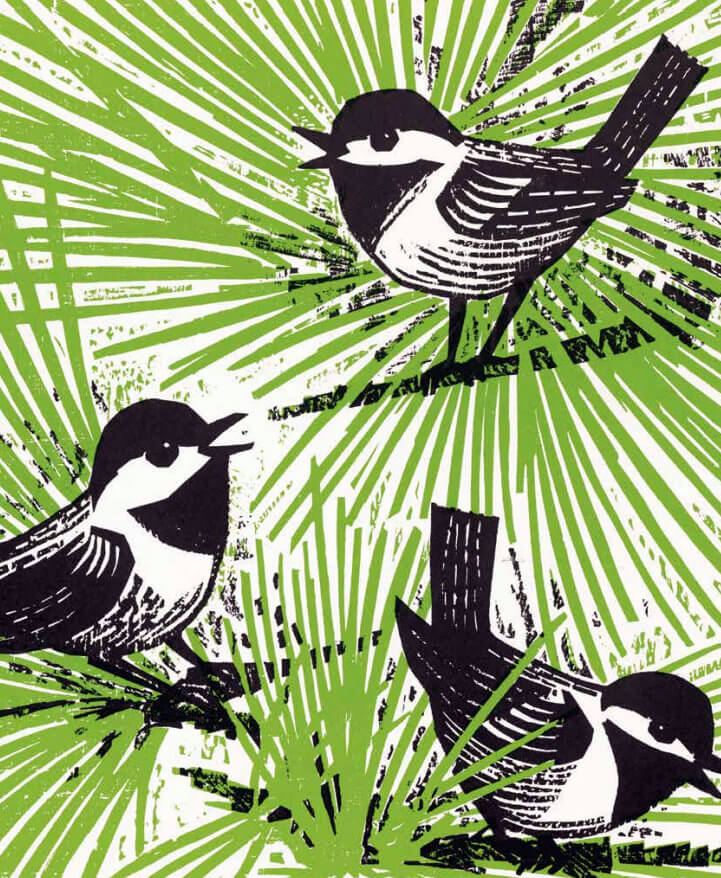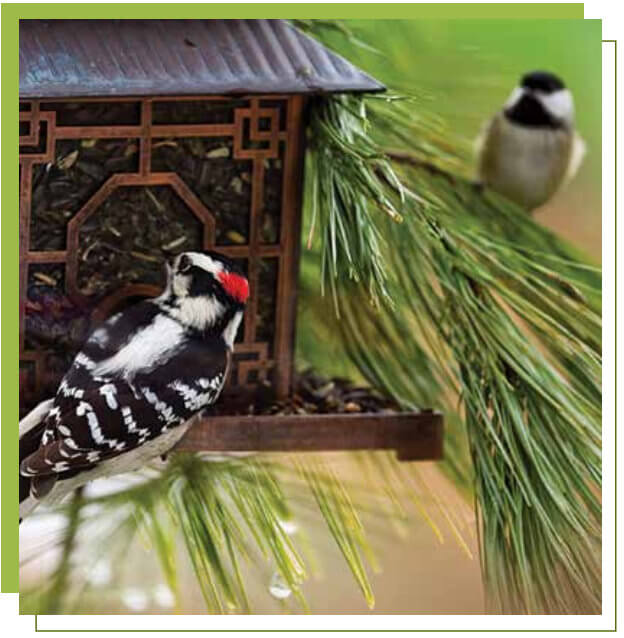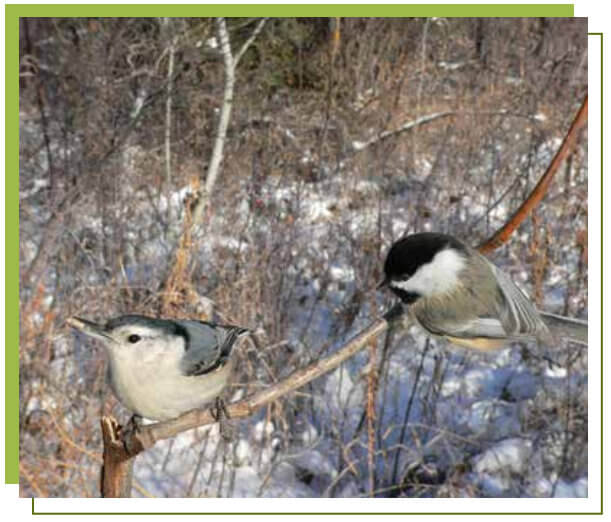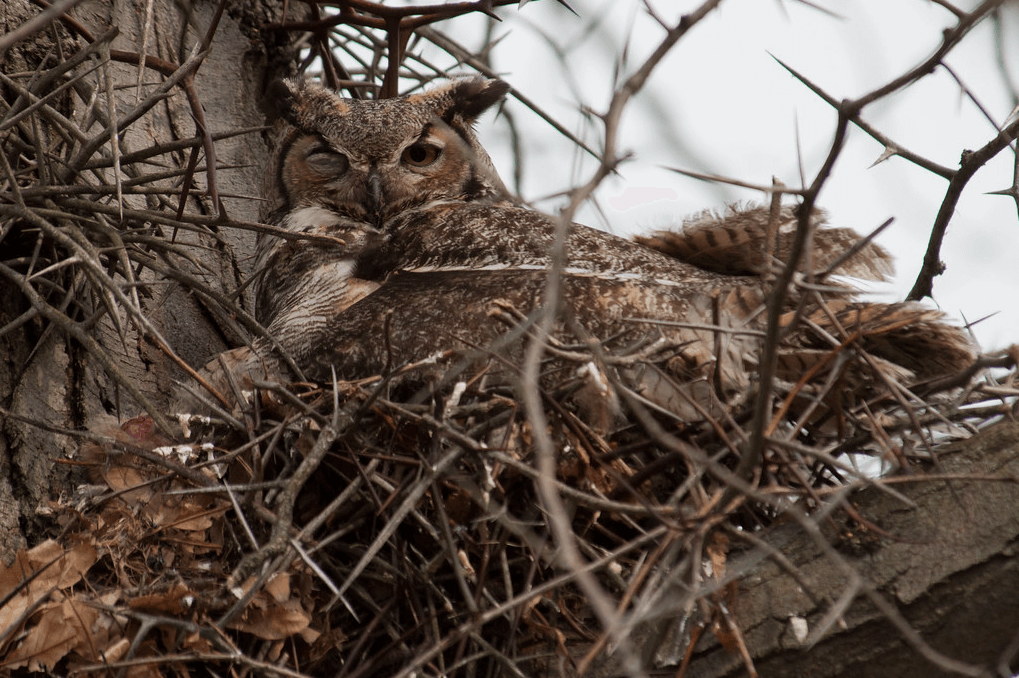by Cedar Mathers-Winn

CSA images/color printstock collection.
If you ask any birder or naturalist, they will probably tell you that spring is the season for watching birds. Singing, displaying, fighting and breeding—spring is a time of great activity, and it’s hard not to take notice. By comparison, winter may seem quite dull. But just watch for a moment, and you’ll see that there are fascinating things going on all around you.
It might take a moment of standing silent before we even begin to notice the birds. A few soft contact calls here, a fluttering of wings there; first just one or two, then perhaps a few more in the adjacent trees. Gradually we realize that these birds are not isolated; they are part of a flock, foraging together, picking their way from tree to tree.
Keep watching. Who are these birds moving quietly among the branches? These flocks usually include several different species of birds. Nuthatches, chickadees, woodpeckers, and others may all be found sharing each other’s company, foraging and flying together in dispersed groups as they move from patch to patch.
But what makes these flocks especially interesting are the ways these different species interact and even communicate. Looking a little closer, one might notice consistencies in the numbers of species that make up these flocks. While there might be one or two of a given species of woodpecker or nuthatch, there are usually much greater numbers of chickadees, sometimes up to a dozen. And if you were to watch for a little while, you might notice that when the flock moves, it is usually the chickadees that fly first, with the other birds following after. It is fair to say that these chickadees are in fact leading the flock.
Mixed-species foraging flocks are quite common throughout the world. Just about anywhere you go, different species of woodland birds will flock together in the winter. And the similarities don’t stop there. Chickadees and their relatives in the family Paridae (which also includes the Titmice and Old World Tits) are the leaders of these mixed wintering flocks wherever they occur. As interested citizens of the natural world, when we see persistent patterns like this, we have to ask—why?
Biologists have been puzzling over this question for decades, and have come up with several explanations for this surprisingly common phenomenon. One compelling idea is that larger groups are safer because any one bird has a lower chance of being singled out and caught by a predator—just like with schools of fish. This certainly applies to mixed flocks as well, but really doesn’t explain why birds should so often hang out with other species. Presumably, this “safety in numbers” benefit depends on the size of the group, not so much who’s in it. This idea also fails to explain why some species would follow others around.

Photo by Trudy Wilkerson, depositphotos.com.
Birds might also benefit from better surveillance of the landscape, and thus better detection of predators. This idea has the strongest scientific support, and explains a number of interesting patterns we see in mixed-species flocks. Many birds will spend less time looking out for predators when they are in larger groups, and thus can spend more time foraging. This is true especially when there are other species around. Our Downy Woodpeckers, for instance, will spend less time looking for danger in the company of chickadees. The benefit of this is twofold: of course, knowing when there is a predator in the area could save a bird’s life. But birds still need to eat, and more time spent looking for predators means less time feeding. By sharing vigilance duties with the flock, each bird is not only safer, but can also spend a little more time feeding. In winter, it is crucial that birds maintain their fat stores as best they can, so even a little extra time spent foraging could make a huge difference. But still, couldn’t this all be accomplished in single-species flocks, without one species “leading” the others? And why should chickadees in particular be the leaders?
To answer these questions, we need to dig a little deeper into just how the flock reacts when a bird actually does detect a predator. Like many other animals, birds give characteristic calls when they sense that they are in danger. These calls can be quite different depending on the particular situation, and as such can cause listeners to respond quite differently as well. These “alarm” calls alert other animals, and often carry detailed information about the predator itself. This information can be useful to any other prey animal in the area—knowing how to respond to a predator could mean the difference between life and death. The best way to respond to a hunting cat, for example, might be to fly up to an open branch and look around on the ground. But if the predator was a bird-eating Sharp-shinned Hawk, the same escape maneuver would probably put the bird in even greater danger. The appropriate response would probably be to dive for the nearest cover.
A predator might be walking, flying, or stationary; it could be dangerous only to adults, to nestlings, or both; it might have been seen, or only heard—such distinctions can be critical for survival, and can be communicated with an alarm call. Two of the most common types of alarm calls are given to raptors, and indicate differences in their behavior. “Seet” calls are typically given to flying raptors. A bird-eating raptor in flight is about the most dangerous thing an unsuspecting songbird could encounter—striking silently from the air, these specialists are extremely agile and effective hunters. The response of a songbird must be quick if it is to survive. Accordingly, birds respond to seet calls very strongly; they dive for cover, or, if no cover is available, they freeze. Surprisingly, birds fleeing in response to seet calls will often give seet calls themselves, alerting others that may have been too far away to hear the first alarm.
Seet calls are extremely subtle, and easy to miss for even the most attentive naturalist. They are short, given only a few at a time, and extremely high-pitched, outside of the hearing range of many raptors (and many people). Mobbing calls, on the other hand, are given to perched raptors, and are noisy, loud, and given repeatedly, sometimes for as long as five or ten minutes. Perched raptors are not an immediate threat, so birds respond to mobbing calls quite differently than to seets. Instead of fleeing for cover, birds will actually gather around the hawk or owl, giving their own mobbing calls and sometimes even physically striking the predator. This “mobbing” behavior is extremely loud and conspicuous, which seems appropriate, given that the goal is apparently to harass the predator until it leaves. And a lot of the time, it works—the unwanted raptor will leave, and may avoid the area for some time after. Mobbing calls often attract great numbers of birds to the predator, many of whom will join the mob themselves. If you have ever seen a flock of crows, jays, or other birds cawing and diving at a perched hawk, you have seen mobbing in action.

Photo by Jason Cheever, bigstock.com.
Alarm calls are what make sharing vigilance possible. Because of these calls, members of a flock don’t need to look up from feeding to know that there is a predator around, or even how to best respond to it. Many birds give similar types of alarm calls, but some birds call more than others, and some birds’ calls convey more information than others’. And this brings us back to chickadees. Black-capped Chickadees, for instance, are especially vigilant, and are often the first birds to sound the alarm. Their alarm calls are also quite complex, and because of this they can communicate highly informative messages about a predator—messages that motivate life-saving behaviors. They probably give these calls primarily to help each other out—chickadees are highly gregarious with their own species—but in doing so, they put some very useful information out into the world, available to anybody who hears it. Other birds just have to be within earshot. So, to best take advantage of this free information, many other birds will basically follow chickadees around and mooch off of their alarm calls. And while less-social followers like woodpeckers are able to forage more and spend less time looking for danger, the chickadees don’t get the same benefits from the woodpeckers—basically, chickadees do all the work, and get very little in return!
This isn’t the harmonious picture of nature that many of us are accustomed to, but close up nature is rarely so idyllic. Rather, it is messy, unfair, and often brutal. But uneven relationships like these keep everything in balance overall. Without the chickadees, other birds would be much more vulnerable to predators, and might be much less successful as a species. All these different factors and interests are what give us the fascinating, perplexing, and intricate patterns that we see. We are only just beginning to understand what’s really going on with these mixed-species flocks, and with alarm calling in general, but we can be sure that these complex relationships will give us much to ponder for years to come.
Cedar Mathers-Winn is a biologist and naturalist, a basement composer and recordist of all things audible. He is currently a graduate student at the University of Montana, and studies alarm behavior and communication in local forest birds.
Interested in learning more? Here are some additional resources:
- Marler, Peter. “Characteristics of some animal sounds,” Nature 176, pgs. 6-8 (1955). (This is a classic paper describing two of the most basic forms of alarm calls, given by many species of birds and some mammals.)
- Sridhar, H. et al. “Why do birds participate in mixed-species foraging flocks? A large scale synthesis,” Animal Behaviour 78, pgs. 337-347 (2009).
- Sullivan, K.A. “Information exploitation by Downy Woodpeckers in mixed-species flocks,” Behaviour 91:4, pgs. 294-311 (1984).
- Templeton, C., et al. “Allometry of alarm calls: Black-capped Chickadees encode information about predator size,” Science 308, pgs. 1934-1937 (2005).
This article was originally published in the Fall 2017 issue of Montana Naturalist magazine, and may not be reproduced in part or in whole without the written consent of the Montana Natural History Center. ©2017 The Montana Natural History Center.
Click here to read more articles from Montana Naturalist magazine.
Want to learn more about our programs? Sign up for our e-newsletter! You can also become a member and get discounts on our programs as well as free reciprocal admission to 300+ science centers in North America!












